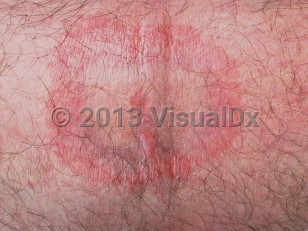Early disseminated disease occurs within weeks as the spirochete disseminates to the nervous system, heart, joints, and other organs. At this time, patients may develop multiple widespread skin lesions of disseminated EM along with acute neurologic abnormalities, atrioventricular (AV) block, or myocarditis.
In the United States, Lyme disease is primarily seen in New England, the Midwest states, and the west coast. It is endemic to most of Europe. The ticks that transmit Lyme disease are of the genus Ixodes (eg, Ixodes scapularis, the blacklegged tick or deer tick). Mice and deer are the major animal reservoirs. Transmission occurs most commonly in the spring and summer months. Increased risk of infection is strongly linked to the amount of time spent in wooded or rural areas.
Lyme disease has been rarely reported in China, Japan, and Russia. Although Lyme disease is not considered endemic to countries in Africa, there have been few cases of infection reported.
Rarely, coinfection with Babesia microti has been documented in adults.
Lyme disease is subdivided clinically into 3 phases:
- Early localized disease
- Early disseminated disease
- Late disease
Systemic symptoms are seen in approximately half of patients with early localized or early disseminated disease. These symptoms are described as flu-like and include a combination of fatigue, headache, neck stiffness, myalgias / arthralgias, lymphadenopathy, or fever. With B mayonii infection, which at present seems to be limited to the upper midwestern United States, nausea and vomiting may also occur, and the rash may be more diffuse.
Stage 1 - Early Localized (days to weeks following tick bite):
- EM at the site of the tick bite develops in approximately 60%-90% of patients.
- In Europe, early lesions sometimes present as Borrelia lymphocytomas.
- There may or may not be systemic symptoms.
- False negative serological testing is common.
- Multiple widespread skin lesions represent dissemination of the infection with or without systemic symptoms.
- Approximately 10%-15% of patients develop neurologic features including meningitis and cranial or peripheral neuropathies. Facial nerve palsy (Bell palsy) is the most commonly associated cranial nerve neuropathy. Borrelial meningoradiculitis, often called Bannwarth syndrome, is a rare manifestation (especially in Europe) associated with painful myeloradiculitis, lymphocytic meningitis, and cranial nerve palsies as well as motor weakness, headache, sleep disturbances, and sometimes gastrointestinal symptoms.
- Approximately 5% of patients may experience cardiac manifestations, usually AV block or myocarditis.
- Serological testing is usually positive, but false negatives may still occur.
Untreated cases can also lead to:
- Chronic arthritis (typically knees)
- Mild encephalopathy with subtle cognitive deficits
- Axonal polyneuropathies
- Acrodermatitis chronicum atrophicans (Europe)
- Serological testing is virtually always positive.
A small percentage of patients diagnosed with Lyme disease who received adequate therapeutic treatment have reported ongoing nonspecific symptoms that typically improve within one year. Persistent infections in humans despite treatment have not been reliably demonstrated. Despite extensive study of this entity, numerous expert reviews have concluded that no consistent, reproducible syndrome or evidence of persistent infection resulting in these vague symptoms exists. However, primary reinfection has been demonstrated in individuals in endemic areas.
Related topic: Lyme keratitis



 Patient Information for
Patient Information for 
